
August 8th, 2011
Location
Jammu and Kashmir is the northernmost state of India. It is situated mostly in the Himalayan Mountains. Jammu and Kashmir shares a border with the states of Himachal Pradesh and Punjab to the south and internationally with the People’s Republic of China to the north and east and the Pakistan-administered territories of Azad Kashmir and Gilgit-Baltistan, to the west and northwest respectively.
Formerly a part of the erstwhile Princely State of Kashmir and Jammu, which governed the larger historic region of Kashmir, this territory is disputed among China, India and Pakistan. Pakistan, which claims the territory, refers to it as “Indian-occupied Kashmir” (IoK) while most international agencies, such as the United Nations, call it “Indian-administered Kashmir.”
Jammu and Kashmir consists of three regions: Jammu, the Kashmir valley and Ladakh. Srinagar is the summer capital, and Jammu is the winter capital. While the Kashmir valley is famous for its beautiful mountainous landscape, Jammu’s numerous shrines attract tens of thousands of Hindu pilgrims every year. Ladakh, also known as “Little Tibet”, is renowned for its remote mountain beauty and Buddhist culture.
History
Hari Singh had ascended the throne of Kashmir in 1925 and was the reigning monarch at the conclusion of British rule in the subcontinent in 1947. As a part of the partition process, both countries had agreed that the rulers of princely states would be given the right to opt for either Pakistan or India or — in special cases — to remain independent. In 1947, Kashmir’s population was 77% Muslim and it shared a boundary with Pakistan. On 20 October 1947, tribesmen backed by Pakistan invaded Kashmir.
The Maharaja initially fought back but appealed for assistance to the Governor-General Louis Mountbatten, who agreed on the condition that the ruler accedes to India. On October 25th 1947, Maharaja Hari Singh signed the Instrument of Accession and it was executed on October 27, 1947 between the ruler of Kashmir and the Governor General of India. Once the papers of accession to India were signed, Indian soldiers entered Kashmir with orders to stop any further occupation, but they were not allowed to expel anyone from the state. India took the matter to the United Nations. The UN resolution asked both India and Pakistan to vacate the areas they have occupied and hold a referendum under UN observation. The holding of this plebiscite, which India initially supported, was dismissed by India because the 1952 elected Constituent Assembly of Jammu and Kashmir voted in favor of confirming the Kashmir region’s accession to India. Another reason for the abandonment of the referendum is because demographic changes, after 1947, have been effected in Pakistan-administered Kashmir, as generations of Pakistani individuals’ non-native to the region have been allowed to take residence in Pakistan-administered Kashmir. Furthermore, in Indian-administered Kashmir, the demographics of the Kashmir Valley have also been altered after separatist militants coerced 1/4 million Kashmiri Hindus to leave the region. Moreover, Pakistan failed to withdraw its troops from the Kashmir region as was required under the same U.N. resolution of August 13, 1948 which discussed the plebiscite.
Diplomatic relations between India and Pakistan soured for many other reasons,and eventually resulted in three further wars in Kashmir the Indo-Pakistani War of 1965, the Indo-Pakistan War of 1971 and the Kargil War in 1999 where Pakistan suffered crushing defeats in the hands of a much powerful India. India has control of 60% of the area of the former Princely State of Jammu and Kashmir; Pakistan controls 30% of the region, known as Gilgit-Baltistan and Azad Kashmir. China has since occupied 10% of the state in 1962.

The eastern region of the erstwhile princely state of Kashmir has also been beset with a boundary dispute. In the late 19th- and early 20th centuries, although some boundary agreements were signed between Great Britain, Tibet, Afghanistan and Russia over the northern borders of Kashmir, China never accepted these agreements, and the official Chinese position did not change with the communist takeover in 1949. By the mid-1950s the Chinese army had entered the north-east portion of Ladakh.
By 1956–57 they had completed a military road through the Aksai Chin area to provide better communication between Xinjiang and western Tibet. India’s belated discovery of this road led to border clashes between the two countries that culminated in the Sino-Indian war of October 1962. China has occupied Aksai Chin since 1962 and, in addition, an adjoining region, the Trans-Karakoram Tract was ceded by Pakistan to China in 1963.
Political & Militant Insurgence
For intermittent periods between 1957, when the state approved its own Constitution, to the death of Sheikh Abdullah in 1982, the state had alternating spells of stability and discontent. In the late 1980s however, manipulated discontent over the alleged high-handed policies of the Union Government and allegations of the rigging of the 1987 assembly elections triggered a violent uprising which was backed by Pakistan in order to spread disorder & insurgency in J&K.
Since then, the region has seen a prolonged, bloody conflict between Pakistans trained & backed militants and the Indian Army, both of whom have been accused of widespread human rights abuses, including abductions, massacres, rape and looting. The army has officially denied these allegations. However, militancy in the state has been on the decline since 1999, also again in 2004 with the peace process with India and Pakistan. Furthermore the situation has become increasingly peaceful in recent years with the worldwide exposure of Pakistan’s links in worldwide militant activities & backup including sheltering of the notorious Osama Bin Laden in Abbottabad.

Kashmir Valley dominated by ethnic Kashmiri Muslims has largely driven the Azadi campaign. Non-Kashmiri Muslim ethnic groups (Paharis, Sheenas, Gujjars and Bakarwalas), who dominate areas along the Line of Control, have remained indifferent to the separatist campaign. Jammu province region has 70:30 Hindu-Muslim ratio. Parts of the region were militancy-hit, but violence there has ebbed along with the Valley after India and Pakistan started a peace process in 2004.
Dogras (67%) are the single largest group in the multi-ethnic region of Punjabis, Paharis, Bakerwals and Gujjars. Statehood is demand in Hindu-dominated districts. Ladakh is the largest region in the state with over two lakh people. Its two districts are Leh (77% Buddhist) and Kargil (80% Muslim population). Union territory status has been the key demand of Leh Buddhists for many years with intense interest of being a part of India.
Jammu and Kashmir is the only state in India which enjoys special autonomy under Article 370 of the Constitution of India according to which, no law enacted by the Parliament of India, except for those in the field of defense, communication and foreign policy, will be extendable in Jammu and Kashmir unless it is ratified by the state legislature of Jammu and Kashmir. Subsequently, jurisdiction of the Supreme Court of India over Jammu and Kashmir has been extended.
Jammu and Kashmir is also the only Indian state that has its own flag and constitution, and Indians from other states cannot purchase land or property in the state. Designed by the then ruling National Conference, the flag of Jammu and Kashmir features a plough on a red background symbolizing labour substituted the Maharaja’s state flag. The three stripes represent the three distinct administrative divisions of the state, namely Jammu, Valley of Kashmir, and Ladakh.
Since 1990, the Armed Forces Act, which gives special powers to the Indian security forces, has been enforced in Jammu and Kashmir. The decision to evoke this act was criticized by the Human Rights Watch.
Like all the states of India, Jammu and Kashmir has a multi-party democratic system of governance with a bicameral legislature. At the time of drafting of the Constitution of Jammu and Kashmir, 100 seats were earmarked for direct elections from territorial constituencies. Of these, 25 seats were reserved for the areas of Jammu and Kashmir State that came under Pakistani occupation, which came down to 24 after the 12th amendment of the Constitution of Jammu and Kashmir:
“The territory of the State shall comprise all the territories which on the fifteenth day of August 1947, were under the sovereignty or suzerainty of the Ruler of the State” and Section 48 therein states that, “Notwithstanding anything contained in section 47, until the area of the State under the occupations of Pakistan ceases to so occupied and the people residing in that area elect their representatives (a) twenty-five seats in the Legislative Assembly shall remain vacant and shall not be taken into account for reckoning the total member-ship of the Assembly; and the said area shall be excluded in delimiting the territorial Constituencies Under Section 47”.
After a delimitation in 1988, the total number of seats increased to 111, of which 87 were within Indian administered territory. The Jammu & Kashmir Assembly is the only state in India to have a 6 year as against the norm of a 5 year term followed in every other state’s Assembly. There was indication from the previous INC Government to bring parity with the other states, but this does not seem to have received the required support to pass into law.
Influential political parties include the Jammu & Kashmir National Conference (NC), the Indian National Congress (INC), the Jammu and Kashmir People’s Democratic Party (PDP), the Bharatiya Janata Party (BJP) and other smaller regional parties. After dominating Kashmir’s politics for years, National Conference’s influence waned in 2002, when INC and PDP formed a political alliance and rose to power. Under the power sharing agreement, INC leader Ghulam Nabi Azad replaced PDP’s Mufti Mohammad Sayeed as the Chief Minister of Jammu and Kashmir in late 2005. However, in 2008, PDP withdrew its support from the government on the issue of temporary diversion of nearly 40 acres (16 ha) of land to Sri Amarnath Shrine Board. In the 2008 Kashmir Elections that were held from 17 November to 24 December, the National Conference party and the Congress party together won enough seats in the state assembly to form a ruling alliance.
Ethnic Kashmiri Muslims, especially those residing in Kashmir valley, demand greater autonomy, sovereignty and even independence from India. Due to the economic integration of Jammu and Kashmir with the rest of India, separatist movements across Kashmir valley were on a decline. However, following the unrest in 2008, which included more than 500,000 protesters at a rally on 18 August, secessionist movements gained a boost.
Economy
Jammu and Kashmir’s economy is predominantly dependent on agriculture and allied activities. The Kashmir valley is also known for its sericulture and cold-water fisheries. Wood from Kashmir is used to make high-quality cricket bats, popularly known as Kashmir Willow. Kashmiri saffron is also very famous and brings the state a handsome amount of foreign exchange. Agricultural exports from Jammu and Kashmir include apples, barley, cherries, corn, millet, oranges, rice, peaches, pears, saffron, sorghum, vegetables, and wheat, while manufactured exports include handicrafts, rugs, and shawls.
Horticulture plays a vital role in the economic development of the state. With an annual turnover of over Rs. 300 crore, apart from foreign exchange of over Rs. 80 Crore, this sector is the next biggest source of income in the state’s economy. The region of Kashmir is known for its horticulture industry and is the wealthiest region in the state. Horticultural produce from the state includes apples, apricots, cherries, pears, plums, almonds and walnuts.
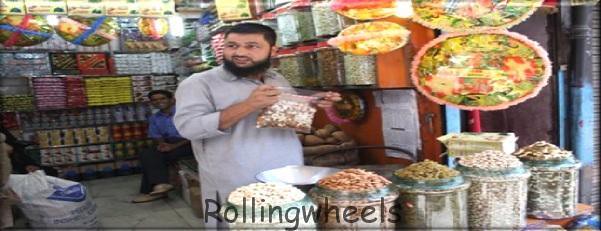
The Doda district has deposits of high-grade sapphire. Though small, the manufacturing and services sector is growing rapidly, especially in the Jammu division. In recent years, several consumer goods companies have opened manufacturing units in the region. The Associated Chambers of Commerce and Industry of India (ASSOCHAM) have identified several industrial sectors which can attract investment in the state, and accordingly, it is working with the union and the state government to set up industrial parks and special economic zones. In the fiscal year 2005–06, exports from the state amounted to Rs. 1,150 crore. However, industrial development in the state faces several major constraints including extreme mountainous landscape and power shortage.
The Government of India has been keen to economically integrate Jammu and Kashmir with the rest of India. The state is one of the largest recipients of grants from New Delhi, totaling $ 812 million per year. It also has a mere 4% incidence of poverty, one of the lowest in the country. In an attempt to improve the infrastructure in the state, the Indian government has commenced work on the ambitious Kashmir Railway project which is being constructed by Konkan Railway Corporation and IRCON at a cost of more than US$2.5 billion. The Jammu & Kashmir Bank, which is listed as an S&P CNX 500 conglomerate, is based in the state. It reported a net profit of Rs. 598 million in 2008.
Before insurgency intensified in 1989, tourism formed an important part of the Kashmiri economy. The tourism economy in the Kashmir valley was worst hit. However, the holy shrines of Jammu and the Buddhist monasteries of Ladakh continue to remain popular pilgrimage and tourism destinations. Every year, thousands of Hindu pilgrims visit holy shrines of Vaishno Devi and Amarnath which has had significant impact on the state’s economy. The Vaishno Devi yatra alone contributes Rs. 475 crore to the local economy annually.
Tourism in the Kashmir valley has rebounded in recent years and in 2009, the state became one of the top tourist destinations of India. Gulmarg, one of the most popular ski resort destinations in India, is also home to the world’s highest green golf course. However with the decrease in violence in the state has boosted the state’s economy specifically tourism.
Culture
Ladakh is famous for its unique Indo-Tibetan culture. Chanting in Sanskrit and Tibetan language forms an integral part of Ladakh’s Buddhist lifestyle. Annual masked dance festivals, weaving and archery are an important part of traditional life in Ladakh. Ladakhi food has much in common with Tibetan food, the most prominent foods being thukpa, noodle soup; and tsampa, known in Ladakhi as Ngampe, roasted barley flour. Typical garb includes gonchas of velvet, elaborately embroidered waistcoats and boots, and gonads or hats. People, adorned with gold and silver ornaments and turquoise headgears throng the streets during various Ladakhi festivals.
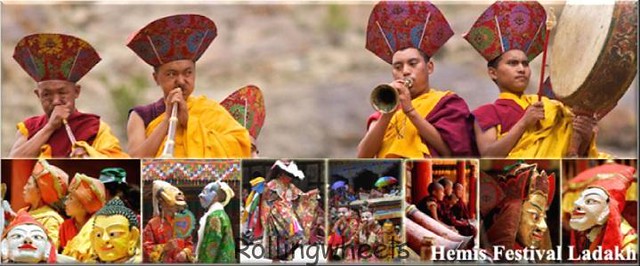
The biggest and most famous of the monastic festivals is that of Hemis, which falls in late June or early July, and is dedicated to Padmasambhava. Every 12 years, the gompa’s greatest treasures, a huge Thangka, is ritually exhibited. Its next unveiling is due to take place in A.D 2016. Other monasteries, which have summer festivals, are Lam (late July/early August), Tak-thok (after Phyang) and Karsha in Zanskar (after Phyang). Like Hemis, the Phyang festival too involves the unveiling of a gigantic thangka, though here it is done every third year. The Dumhal is a famous dance in the Kashmir valley, performed by men of the Wattal region. The women perform the Rouff, another traditional folk dance. Kashmir has been noted for its fine arts for centuries, including poetry and handicrafts. Shikaras, traditional small wooden boats, and houseboats are a common feature in various lakes and rivers across the Valley.
The Constitution of India does not allow people from regions other than Jammu and Kashmir to purchase land in the state. As a consequence, houseboats became popular among those who were unable to purchase land in the Valley and has now become an integral part of the Kashmiri lifestyle.
Kawa, traditional green tea with spices and almond, is consumed all through the day in the chilled winter climate of Kashmir. Most of the buildings in the Valley and Ladakh are made from softwood and is influenced by Indian, Tibetan, and Islamic architecture.
Jammu’s Dogra culture and tradition is much similar to that of neighbouring Punjab and Himachal Pradesh. Traditional Punjabi festivals such as Lohri and Vaisakhi are celebrated with great zeal and enthusiasm throughout the region, along with Accession Day, an annual holiday which commemorates the accession of Jammu & Kashmir to the Dominion of India. After Dogras, Gujjars form the second-largest ethnic group in Jammu. Known for their semi-nomadic lifestyle, Gujjars are also found in large numbers in the Kashmir valley. Similar to Gujjars, Gaddis are primarily herdsmen who hail from the Chamba region in Himachal Pradesh. Gaddis are generally associated with emotive music played on the flute. The Bakkarwalas found both in Jammu and the Valley of Kashmir are wholly nomadic pastoral people who move along the Himalayan slopes in search for pastures for their huge flocks of goats and sheep.
Jammu and Kashmir is known as heaven on earth. In the seventeenth century the Mughal emperor Jahangir set his eyes on the valley of Kashmir. He said that “If paradise is anywhere on the earth, it is here”. Persian poet ‘Firdousi’ while living in a houseboat on the mesmerizing Dal Lake said “Gar firdaus, ruhe zamin ast, hamin asto, hamin asto, hamin asto.” If there is ever a heaven on earth, it’s here, it’s here, it’s here.
The obvious debate arises, ‘Kashmir…The Land of Terror or The Paradise on Earth!! ’
The Theme
We, Rolling Wheels Bikers Club set out to search for the truth, to extensively travel every part of J&K, interview every friend we make on our journey & find out their take on this matter & of course, witness the eternal beauty of the ever beautiful state.
To most bikers/motorcyclists touring Kashmir refers to Ladakh i.e. Zojila Pass, Baralacha La, Khardung-La, Leh, Kargil, at the most Marsimek-La & THAT’S IT!! The same old postures infront of same old milestones that read, “You are at the world’s highest motorable road, unbelievable, isn’t it??” & “You are at the worlds 2nd highest motorable road, unbelievable, isn’t it??” & so on… No doubt these are points of achievement but as we believe, “There is a thin line of difference between a motorcyclist & a motorcycle traveler.” Rolling Wheels Bikers Club is a hardcore Motorcycle Travel club. When we roll, we start with a definite motto. Every tour of Rolling Wheels carries some motto behind its planning. The tour of J&K had 2 serious mottos in store.
1. To seek out the True nature of the highly media publicized “Land of Terror”.
2. To encourage and facilitate travelling in and around J&K after the massive flashflood in Leh last year.
The Team
The Dream team comprised of 5 people:

One of the three founder members of Rolling Wheels Bikers Club & A veteran Motorcycle Traveler, Krish is a meticulous planner & executor by nature. Krish leads his life with only one obsession…Rolling Wheels Bikers Club. He has sacrificed half of his life & belongings for this club. This ride has been one of his missions/Challenges that he had set for himself reason being his midway return from the same tour in 2005 due to a broken wrist.

Cool as a cucumber & a saddle-sore happy rider of Rolling Wheels Bikers Club, Shantanu can be defined as the perfect lead in group riding. Outstanding navigational skills with nearly perfect Time & distance Calculation makes him an indispensable rider in any tour of Rolling Wheels. Shantanu is one among the three founder members as well. A veteran rider with a strong bondage with Krish. This ride has been equally important to him for the same reason as Krish. The journey He & Krish began in 2005 needs to be completed.

Though he owns a New Royal Enfield Thunderbird, he had to buy a Std 350 for this tour, thanks to the legal suit being contested with Enfield India. The poor guy couldn’t even lay hands on his new ride before it started showing serious engine issues. Gentle in nature but extremely determined in the inside, Jayanta had staked all for this tour. He bought another ride, made necessary repairs, seasoned the engine & traveled throughout without any hint of trouble. Behind his lady-killer looks lives a true warrior. The only guy to return by road from this tour. Hats off!!

Unpredictable & Unstoppable in nature, this guy is a true daredevil. One of the rare motorcyclists who can repair almost any Indian bike, head to tail. I say Indian coz he hasn’t tried any Hayabusa yet. One would always see him dissembling / repairing something or the other, be that his bike or his brand new mobile phone. No matter what situation…Biswa is always there for help, that too with a smile. After resolving the problem, He would look up to others & ask…”Boss Kaun??” An asset for any club.

Finally, Me!! With Motorcycle Traveling in blood which I share with Krish, I, Shantanu & Krish set up the concept of Rolling Wheels Bikers Club with the intention of facilitating & encouraging motorcycle touring amongst Bikers. After traveling all over India & Nepal, I have always looked up to the skies and asked, “When do I touch you?” Finally, after 8 years of motorcycle touring, I have reached the skies. I have seen Paradise. Now, I look to fulfill a wonderful dream I once saw, a twilight when I shall be high on the edge of the mountains, so high that the world would be right beneath me, with dense snow fall, with wrinkled skin & white hair & there I shall breathe my last. On my Bike, on Buddy!!
Two other members were scheduled to join the ride from Manali. They were:

You won’t find much about Kedarnath in this travelogue since he had to abandon the tour midway from Srinagar due to nerve related issues. Well, this tour is not a piece of cake. Tours like this require immense discipline, mental strength, a cool nerve & of course enough riding skills to meet the challenges of steep, dusty, broken & narrow roads with genuine altitude issues.

A hardcore passionate traveler who enjoys every moment of his ride, Subroto is a man to learn from. The eldest man in our team but the most versatile & is perhaps one of the friendliest guys I have met. Subroto was unfortunate not to complete this ride but made it upto Leh before falling sick due to AMS. I am sure, one day I would see him riding farther on to Khardung La or Pangong Tso. We missed him a lot…no doubt!! Subroto has surrendered his life to Two things…Ludmilla & Ludmilla!!
Media Attention
Mahuaa Khobor (a 24X7 Bengali news channel)
& Mahuaa Bangla (a 24X7 Bengali soap Channel)
wanted to cover our ride & sent us one journalist & one cameraman who rode with us throughout the tour. Their mission was to make an 11 episode travel documentary on Motorcycle Touring in J&K and a one hour movie documentary of the same. They rode with us as pillions on Buddy & 1052. Both of them proved to be fantastic travel partners co-operating & helping us in every possible way, sometimes even packing & saddlebag mounting. After a couple of days it was hard to determine that they are not motorcycle travelers but journalists. Their attitude, adaptation, temperament & pillion skills were worth a salute. We thank them especially for enduring a 30day painful journey due to saddle-sore with minimum complains. Their reaction to most of the bumps & jerks was “Oooh!! Tirtho!!”, which they sounded more of ecstasy to pain, thus encouraging me on the bumpy rides towards each destination. Ha ha ha…funny!!… but their urge to adapt & co-operate is worth a grand salute.
Here they are:

Symantak Ghosh: Journalist as well as a gifted & awarded photographer. Also a superb guitarist.

Satanjib Gupta: A highly skilled cameraman & Singer.
The route we planned to take & places we decided to travel are on the map:
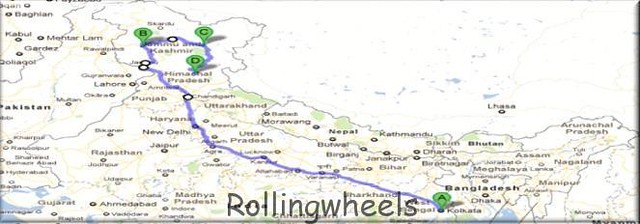
The Ride Begins
June 6th…. early morning at 4.30am the team of Rolling Wheels Bikers Club sets off for its everlonged Tour of Jammu & Kashmir. Most of us have trained hard & long for this day. Every day since we started Motorcycle touring, we have trained & prepared ourselves for this epic tour longing to ride on the top of the world someday & one fine morning like a snap of a finger, the morning is greeted on the Durgapore Expressway (NH2) with sounds of roaring engines & top level excitement. Some of our clubbies rode with us until Hamid’s dhaba (RW’s tea junction on NH2) some 18 kms from our club where we had our morning tea with lots of Glucose biscuits. Honestly, I was the one who had a couple of packets with the tea. I have developed a funny habit of feeling hungry at the start of every ride.
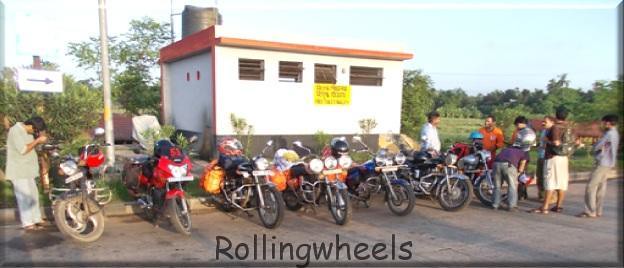
With bellyful of biscuits & heartful of best wishes & hugs from Suprobhat da, Chandu da, Somjeet & other clubbies, The High Rev Engines Roared, The Enfields Thundered & THUMP THUMP THUMP THUMP THUMP. We are off to Ladakh.
The ride plan for 6th June was to start from Rolling Wheels Bikers club in Kolkata & reach Varanasi for the night. 7th June, we planned to visit Varanasi & on 8th June early morning we would start for Delhi where Syamantak & Satanjib would be waiting for us in Paharganj. They are scheduled to reach Delhi on 8th straight from Germany where Symantak would be receiving an award for photography. A gifted photographer as I mentioned earlier.
Destination of the day: Varanasi
The NH2 seemed to be clam, straight & uneventful as usual until just a few kms before Asansol, I noticed Buddy (My Avenger220) was not performing to its brim. The clutch release was too slack & the bike was vibrating a lot in every gear change. It had something to do with the clutch. I started to feel frustrated since it’s just been a couple of days that I had changed the clutch plates & spent four thousand bucks in Bajaj probiking, thanks to their ridiculous billing & repeat servicing with repeat billing habits. This has been a serious issue among most Bajaj owners with ‘Autocentre Probiking’. Complains to the company never leads to results. After all, they are enjoying absolute monopoly in & around Kolkata.
The way Buddy was performing made it clear that it was by no means ready to take the strain of this tour. Something has to be done & it has to be done quickly. I remembered being helped by a Bajaj showroom in Asansol called ‘Automoovers’ in the tour of Nepal. Krish made a distress call to its owner Mr. Rajesh Daruka & he asked us to come down to his showroom & assured us that all spares would be kept ready by then & all help would be given. This was not surprising to us since we all remembered how this man & his staff helped us in the Nepal tour. I wish I had done my pre-tour servicing from them. This is one rare place where one feels proud to be a Bajaj owner.
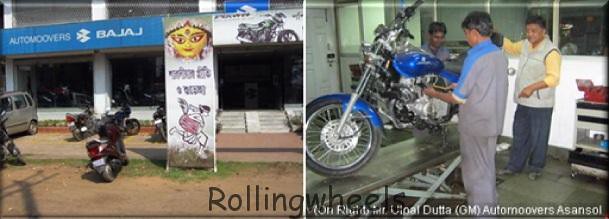
We reached Asansol ‘Automoovers’ at 11.30am to receive a warm welcome from the owner & his staff. There were cold drinks & sweetmeats all round as if some VIP have stepped in. These are the moments when you feel proud to be a traveler. A Motorcycle Traveler!! While all these welcome & greetings, I noticed my bike’s repair job has already began & two mechanics after taking a test ride has started with their job. Meanwhile Jayantada faced a peculiar problem of his bikes tool box lock being broken & set off to look for the necessary spare. Enfields, as usual are full of surprises.
Before starting for ‘Automoovers’ Jayanta decided to draw a pollution certificate from a centre just beside us. This was one of the most hilarious moments of our ride. The guy at the centre seemed to be more inclined in playing Teenpatti (Poker) than carrying out his job & instructed us to do a self service checkup. Hence, Jayanta did it all by himself & sat by the computer to make all necessary corrections & take a printout. We now call it, ‘The self service pollution station’.
At about 3pm our bikes were ready to roll & I was a little worried at the upcoming bill for the new clutch plates & its labour charge. A new 1150ml jar of DTSI10,000 20W50 was poured as well. I was expecting a hefty bill of Rs.3500+ considering my experience with Kolkata Probiking service centre. To my surprise, they produced a bill of Rs.1700 only. At first I thought they had missed out something. Then I came to know that they had only taken their cost price of the spares & engine oil. I couldn’t even convince them to take the labour charges for the job done. With lots of hugs & Goodbyes we resumed our journey. Varanasi was no longer possible. We decided to roll on until dark. After driving for about 83kms we reached a small township called Topchanchi. It is 37 kms from Dhanbad. Off the NH2 a road leads to artificial lake at Topchanchi. It was excavated along the slope of Parasnath Hill in 1915 to supply water to Jharia. Situated in a cool, calm, quite and beautiful environment, it is variable paradise to nature lovers just 6 kms from Gomoh, where Neta ji Subhash Chandra Bose boarded the train for his historical departure from India on the 18th Jan 1941. As remembrance of this incident a statue of Neta ji was installed in the Topchanchi market. (Caution, do not move inside the jungles, anytime you can expect criminals and dacoits).
Some 15 kms after Topchanchi we noticed lots of weapons shops proudly displaying their varied products starting from sticks to Knives & swords. It was a little surprising to me to see a highly illegal arms trade being carried out right on the open National Highway. Then suddenly I realized…after all its ex-Bihar. Law here takes its course according to the whims & needs of politicians & Bahubalis. Locals & shopkeepers boasted that nearly all members of every household here is an expert in weapons manufacturing & they also have export quality samurai swords which are not on display due to some reason. One does not require a license, a permit for these. All you need is the cash & the product’s yours.
It proved to be a hectic day for us & we started to feel tired. Mental tiredness is a serious issue on highways. After driving for a couple of hours in the dark Bishwa started to feel sleepy & suddenly made a wild twist on the lonely highway. I came parallel to him & asked what had happened. Bishwa seemed visibly shaken & replied, “I think I am hallucinating due to tiredness. I thought I saw a huge bull right infront of me”. This is what happens if one does not sleep well before a ride. He has spent two sleepless nights in anticipation & excitement of this tour. Now, the tired body is retaliating. We decided to reach Barhi (A small township in Jharkhand) & find a hotel for the night.
Barhi is a census town and headquarters of a subdivision in Hazaribagh district in the state of Jharkhand. It stands at the crossing of NH2 / Grand Trunk Road and NH 31 and NH 33. Both Tilaiya Dam of DVC and Hazaribagh National Park are near Barhi. In spite of its importance Barhi has not developed itself as a tourist spot hence hotels are genuinely scarce there. To make matters worse, our appearance after a full days ride was not pleasant enough to make a good first impression. Most of the hotels gave us a cynical look and refused rooms saying the hotels are full. It was hard to imagine how all hotels had their rooms full in this tourist forsaken place. At last Krish managed to find a hotel whose manager was a Motorcycle enthusiast himself. He allotted us rooms at a reasonable price in exchange of our visiting cards. The reason behind this generosity was his intense eagerness to join Rolling Wheels & become a motorcycle traveler. After having dinner with Egg curry & Dal, we surrendered ourselves to bed without hesitation & soon our nasal engines were on the roar. Jayantada revved his engine at its limit until Biswa’s elbow landed heavily on his ribs. Very soon all of us became busy in nasal conversation with each other. The ride plan for the next day was until Allahabad.
Destination of the day: Allahabad
We started from the hotel bound for Allahabad at 6.45PM and decided to make a Tea halt in a roadside dhaba at 8.30PM. We knew this tour is going to be an ultimate test of mental & physical strength but imagining situations & facing them practically are two entirely different scenarios. Everything seemed to be against us. The hot & dry weather, the dusty & broken roads, the sun burns itching terribly, the blisters on the wrists, lack of drinking water, everything. The drinking water we carried was so hot that one could easily make tea out of it. The only things that drove us forward is the passion for travelling, the dream to ride on the top of the world, the ambition to become a respected biker, the urge to do something different from the daily life. I asked Bishwa jokingly, “Should we go back to Kolkata & try this on a cooler weather?” Bishwa replied, “Only my dead body would return midway!!!” That’s the passion we carry for travelling, that’s the desperation we carry to fulfill our dreams, that’s the ambition that has given us a place amongst the most respected bikers, that’s the undefeatable urge that makes us do something different!!
This part of the ride was perhaps one of the most uncomfortable episodes of the entire tour. We started from Barhi at 6.45Am with a fresh mind & body. The morning was bright & greeted us with a cool breeze. Two hours of riding seemed to tire us easily.At about 8.30AM, we stopped in ‘Pataliputra Family Restaurant’ for breakfast consisting of Roti, Dal, Bhaji & my mandatory Curd. The Tea halt was converted to breakfast halt since we were sure that we have to make several halts to get relief from the tremendous heat wave even at 8.30 in the morning.
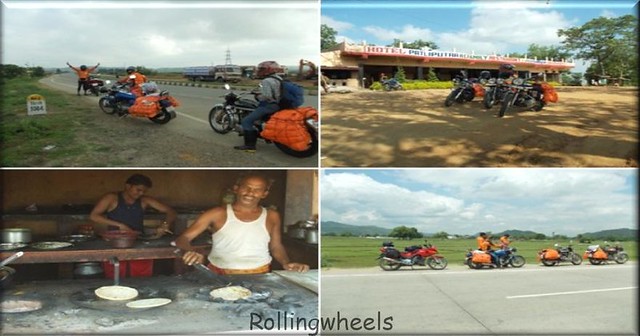
As time passed the weather became hot & the scorching sun was burning every uncovered parts of the body. It was becoming increasingly difficult to ride on in such temperatures. From 10.30Am onwards the heat became unbearable & everyone was dehydrating. Exposed parts like our hands & necks were badly sunburn. Suddenly we saw a Concrete shade which is actually a bus stop. We decided to make a brief halt to have some water & take a rest in the shade.
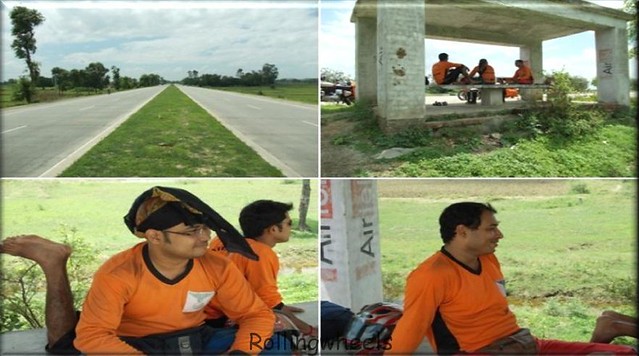
After a 30min halt we decided to ride on until lunch. The concrete road as you can see above is desolate & straight but we were pessimistic to speeding up in fear of overheating the engines due to the extreme hot weather. The dry but extreme weather reminded us that we are nearing the tropics. If this is the weather condition here, how’s that in Delhi?? We decided stop ride to have an early lunch & make the most of it after 3.00pm since it would be comparatively cooler then. At about 12Pm we stopped at a highway dhaba for lunch. Lunch came to us as Chicken curry & rice followed by curd. Curd is a very necessary dish in this weather since it keeps your glucose & fluid level high thus keeping your body cool in this dry & hot weather. After our post lunch cigarette session, we started for Allahabad at about 2pm. All of a sudden we were companied by a biker on an Enfield 350 STD. He seemed to have noticed us from a distance & has caught up with us. We chatted with each other for a while & came to know he is a member of the ‘Jamshedpur Roadmelters’, a Enfield Bullet club of Jamshedpur which is captained by Bharat (a friend of ours) & a good friend of Deepak (Capt. Of Ranchi Bulleteers), who is also a good friend of us. It was quite astonishing to find someone out of the blue who is actually very close to us. The world is a small place…as they say!
After taking numerous halts and uncomfortable driving we managed to reach Allahabad at 10.35pm at night. Krish & Jayanta hurriedly went in search of a hotel and we were asked to convince the nearest McDonalds corner for dinner. There was no restaurant open at that time of night there and the McDonald was the only place possible for food & its chairs were already lined up for closing time. After lots of tears & toil we managed to convince the manager to provide us with a table and four chairs and One ‘Maharaja Burger’ each accompanied by a couple of Pepsi pet bottles. Long Live McDonalds….Long Live the Spirit of Traveling.
After dinner it probably took us a few minutes to get back to hotel, take a bath & find ourselves in dreamland. Jayanta & Krish as usual was on a nasal duel. I was too tired to be disturbed by the rumbling! The ride plan for next morning was until Delhi.
Destination of the day: Delhi
Next morning at 7.30am we went for a tour to Allahabad city. The city itself is beautiful & tidy. We went to visit the sangam where the Ganga & Jamuna & Saraswati rivers meet. The Triveni Sangam, in Allahabad has two physical rivers Ganges, Yamuna, and the invisible or mythic Saraswati River. The site is in Prayag, India. A place of religious importance and the site for historic Kumbh Mela held every 12 years, over the years it has also been the site of immersion of ashes of several national leaders, including Mahatma Gandhi in 1948.
The Triveni Sangam in Allahabad is a confluence of 3 rivers, the Ganges, Yamuna, and Saraswati. Of these three, the river Saraswati is invisible and is said to flow underground and join the other two rivers from below. Here the muddy and pale-yellow waters of the Ganges merge with the blue waters of Yamuna. While the Ganges is only 4 feet deep, the Yamuna is 40 feet deep near the point of their nexus. The river Yamuna merges into the Ganges at this point and the Ganges continues on until it meets the sea at the Bay of Bengal. At the confluence of these two great Indian rivers, where the invisible Saraswati conjoins them, many tirtha yatris take boats to bathe from platforms erected in the Sangam. This, together with the migratory birds give a picturesque look to the river during the Kumbha Mela, in the month of January. It is believed that all the gods come in human form to take a dip at the sangam and expiate their sins.
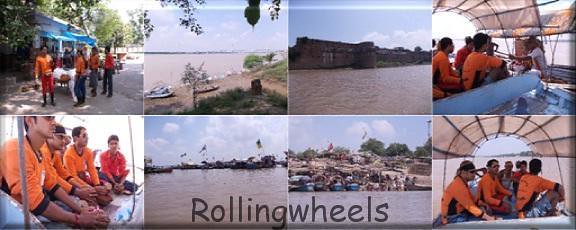
After visiting the Triveni Sangam, we decided to head back towards our hotel & start for Delhi since it was already 11.30am & it was getting hot & humid. Something told me, it was about to rain. Jayanta freshened up using an Rs.5.00 pouch containing max to max 100 ml of cold drinking water. That was the only water permitted in the holy place. Religion means business!!
At 12.30pm we refueled our bikes at a nearby petrol pump & rode on for Kanpur where we decided to have our next break for tea & snacks. The road was like a carpet & the weather unexpectedly was cooler than the day before since it had started raining as soon as we kicked off. Krish & Jayantada decided to start 15 minutes ahead of us from the next halt since we decided to split in two teams & would meet at Kanpur. This was done to avoid taking unnecessary halts since as per our rule if anybody of the team halts the entire team would stop for him. We never leave our team mates behind. Having two teams would create a sense of urgency and tops the mileage (Distance covered per hour).
It was raining like a drizzle & I was on the lead when suddenly I realized Bishwa is not visible in my Rear view Mirror (RVM). I remembered last seeing him on a bend which was watery & we overtook a truck moments after the bend. I remembered Biswa complaining of inadequate road grip on his bikes rear tyre. We stopped aside waiting for Biswa to turn up. 10 mins passed & Biswa was nowhere to be seen. I turned back a few kms to find out if anything had gone wrong. After 5-6 kms, I was informed by some local people that a red bike has had an accident some 12 kms farther. I was horrified!! Never since the establishment of Rolling Wheels in 2005 have we had an accident big or small in nature which is an obvious outcome of the strict discipline & caution we maintain every moment of every ride. I rushed to the scene & found that it was some local biker with a Hero Honda Passion. At that moment my phone rang & it was Krish who informed that Biswa has rejoined the group but somehow has broken his Front brake lever which had cracked earlier in Kolkata when his bike fell off from centrestand after being hit by an Autorickshaw. He had to stop to try and repair it so that we can reach until Kanpur & replace it with a proper spare. I reached back & we decided that Jayantada & Krish would head on for Kanpur whereas we would repair Biswa’s bike at the nearest Hero Honda service centre.
We managed to find a HH (Hero Honda) service centre in Fatehpur, MS Shyam Motors. The service centre falls right on the NH2 but to our misfortune couldn’t provide us with the necessary spare. Instead, they provided us with a HH Passion brake lever which was hardly compatible with the Karizma, but atleast the brake was working. We bid Goodbye to the curious crowd watching us in wonder and resumed our journey for Kanpur.
NH2 just 15 kms before Kanpur suddenly leads to a long flyover where it shows ‘KANPUR’. The road was beautiful & desolate & encouraged us to speed up & we made the most of it howling over speeds of 120kmph. Suddenly I noticed the city of Kanpur was swiftly passing beneath us. It was a confusing situation since both teams were supposed to meet at Kanpur & we were not getting any exit from the 23 kms stretch of the flyover. 8kms after Kanpur the flyover landed us in a small township from where we made a call to Krish & received information that they too took the flyover & was waiting for us 2 kms farther on. A huge sigh of relief was heard from Bishwa who had no intention of turning back 8kms to Kanpur through the congested & broken city road. We rode for a couple of Kms and found Jayantada & Krish waiting for us in a roadside hotel cum restaurant. It was nearly 5.30pm by then.
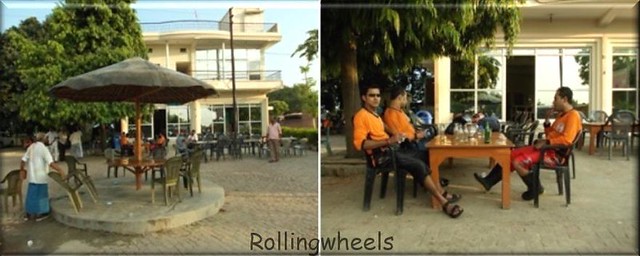
Krish ordered coke & fruit cakes while Bishwa & I seized the opportunity to take a bath in the water fountain beside the hotel. It was actually meant for drinking water purpose but we just couldn’t refrain ourselves from taking a bath in the cold & soft water. It was a huge relief from the extremely hot weather conditions we had gone through today. It had rained a little in Allahabad but a few Kms it was worse than any other day. I remember Krish taking a bath midway in a car service garage from a guy who had been washing a Tata Sumo with his high power water gun. I asked krish, “Does it pain? The force of the water!!” He replied, “The relief comforts the pain.”
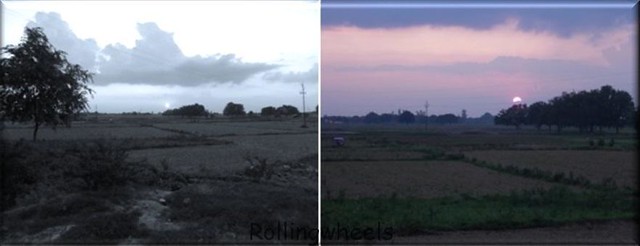
We resumed journey as one team & decided to make a tea halt in Etawah in a small roadside dhaba at about 9.00pm at night. We were in no mood of stopping for now & decided to reach Agra. We were having tea & biscuits when the dhaba owner, a senior man of 70 came up to us & enquired us of our journey. He helped us with his advice on upcoming road conditions & safety at night. He also advised us to take the Agra road instead of the Etawa-Aligarh road which is in very broken & unsafe condition. We decided to take the Agra road & make a 5 hr powernap halt in some hotel in Agra.
Destination of the Night: Agra
At 10.30 pm, we started off towards Agra through the lonely highway. It seemed we were the only humans awake while every other soul is living in wonderland. Kms after Kms we rode our way through small villages & townships with no pair of eyes to be seen, only a couple of lighted bulbs hanging from some closed shop or house giving us a hint of human habitation. At about 11.30pm we entered some place which can be described best as the beginning of a city. The gates of Agra!! We decided to make a brief cigarette halt there & stood beside a market area where every signboard read ‘AGRA’. Suddenly ‘Anuj’, a frail guy in his early 20’s with an aviator goggle clipped unusually in the behind of his shirts collar greeted us with a couple of his friends and enquired about our destination. I can still visualize his face awestruck with the news that we are heading off towards Kashmir on our motorbikes. After a few moments of amazement he said, “Shit!! There ARE some crazy people available. This is Craziest among crazy!!”
After this brief complimenting session, he requested us for a lift till his home which is a couple of Kms on our way. We were a little uncomfortable with this since it is a strict rule of highway riding never to give lift to strangers, especially at night!
We tried to get rid of him through various excuses but I was taken through his innocent but witty talks & decided to take the risk. We decided I would be riding in the middle while the others would surround me from all sides until this excess baggage is dropped home and at any cost we are not going to divert from the highway.
We started off and after a few mins I felt a wobbling tendency on Buddy. It seemed Buddy had gone dizzy. I signaled to the others and stopped my bike and to my horror found out the rear tyre was flat!! A two inch nail somehow found its way through my tyre and punctured the tube. This was the least wanted situation in this dark lonely highway with a stranger. Several thoughts went though our minds…
Is this a trap? Did this guy somehow pierce this nail so that we are compelled to stop?? Is this guy linked with highway robbers??? Where can we get a puncture mechanic now!!
We also realized that the more late we are, the slim our chances become to arrange a hotel in Agra and get some rest. Krish asked Bishwa to reach Agra city and arrange for a hotel while the rest of us would try to repair the damage.
Anuj who stood silent all this while suggested us to ride a few hundred metres further where he said he knows of a puncture mechanic. His house he said was just a few mins walk from there. We reluctantly decided to take his suggestion and reached a small petrol pump with a puncture repairing corner. Anuj jumped off from the bike and woke up the mechanic. It seemed he knew him well because the mechanic was in no mood to work at the middle of the night but Anuj was persistent. The mechanic started working upon Buddy’s rear wheel with Anuj carefully supervising every detail of his work. We asked him to go home since it was getting late and he told us earlier that his father gets very annoyed at his late night ventures but ‘the frail guy with the Aviator goggles tucked in the behind of his collar’ replied, “You helped me in my need, now how can I leave you in your need!! I will stay until your bike is repaired and wave you goodbye. If your friend couldn’t manage a hotel, you must stay at my home for the night. We shall arrange for some dinner for you”
We were thunderstruck!! All this while we have doubted him & now this guy who has known us just for a few minutes is acting like a true friend!!
I hugged him at his generosity and it didn’t take us long to become friends. Rolling Wheels Bikers Club, a Motorcycle Touring Club from Kolkata has made a new friend in Agra, that too at the middle of the night. This is the essence of traveling. This is the spirit of a traveler.
After probably half an hour Bishwa called up to inform he has managed for a room in some Petrol pump just after Agra Bridge at a mere Rs.200. He would be waiting for us there. We decided to reach the Petrol pump and make a stay there. Anuj was a little sad since he wanted us to stay at his house but we did not want to impose upon his old parents at this time of the night. We promised to pay him a visit when we return and started for the Petrol Pump. Buddy, after medication and a stitched wheel seemed fresh and smooth & we with the flavor of a newly acquired friendship rode with high spirits.
So high, we failed to notice Bishwa & the Petrol pump and the opposite lane and zoomed past. After riding for about 5-6 kms we noticed Bishwas headlight in our rear view mirror. He was signaling at us vigorously. We stopped and came to know that we have gone past the Pump nearly 6 kms back and the Pumps caretaker, disgusted at our ignorance decided to call off the deal. Now, we were in a fix. We were absolutely tired and sleepy. We obviously need some rest before starting for Delhi because in Delhi we could rest for maximum half an hour and then start for Chandigarh.
After discussion, we decided to ride on until we find a dhaba (roadside inn) and have our dinner there. After dinner we could rent a Khatiya (roped bed) each and take our Powernap there. The next morning we would start for Delhi.

We managed to find one after a couple of Kms and had our dinner there. While on dinner, Jayanta, Krish & Bishwa decided start for Delhi right after dinner since they were not feeling sleepy. They decided to reach Delhi early and take a sleep in Symantak & Satanjibs room. I was too tired to ride on so I suggested them to ride on and I would start after sunrise. I had to convince them that I would meet them safe and sound in Delhi. In RW, we rarely break our group while on a tour. Traveling alone is one thing but when people travel in a group, a sort of dependency & care acts on every member.
Krish & his group left after a cigarette session post dinner & I took to the luxury of a Khatiya, numerous mosquitoes and thousands of colorful insects attracted by the 250 watt bulb above my head. I just crept into my raincoat, plugged my ears with cotton and Dingggg….!! I fell asleep!!
After an hour my sleep was disturbed by some thoughts that were going through my conscience. Have I done it right to break away from the team?? We are supposed to travel together….then what the hell am I doing here!!! Couldn’t I have bear with them a little more and rode with them until Delhi?? Am I setting a good example???
I jumped out of my bed and cabled my raincoat on my luggage, wore my helmet and VROOOOM….Sped off to join the team…!!!
The Dawn was greeted on the highway with the essence of a fresh morning, a fresh day. Nature, in the dawn is perhaps in its full glory. No words can express the beauty of it when combined with the joy & anticipation of meeting ones dear ones. It was this morning when I wanted to become a poet and was enjoying the new morning at its brim until….I seemed to pass some saffron things…..Yes I did!! I stopped the bike and turned back to notice three sleeping beauties beside the road in front of the gate of an educational institute.
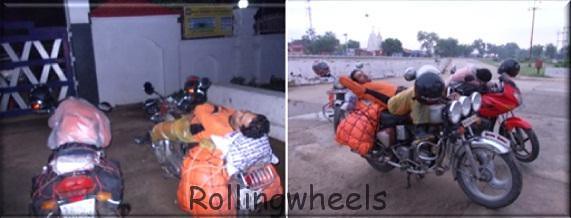
I took the opportunity to photograph these sleeping beauties who claimed to reach Delhi by morning since they were not feeling sleepy and then rode on to a nearby dhaba for the morning tea. I knew they would soon meet me here soon & so they did. With sleepy red eyes they rode in. Krish explained, “well, we were not really sleeping you know….we were just like taking a rest…you know… but Couldn’t you had come a little later, then we would have rested a little more!!” Ha ha ha ha ha….this incident still makes us laugh our hearts out.
I decided to ride on slowly to refrain from cooling down. Once you cool down in this sort of a situation you tend to feel sleepy. After all we have been driving continuously for 18 hours without any proper rest and we were all dead tired. Now we can take a proper rest only in Chandigarh at the evening. That would mean 30 hours of continuous driving with brief halts. That to with the trouble of shooting…takes & re-takes. Satanjib & Symantak would start shooting right from Delhi.
Soon the team re-united and we reached Paharganj (Delhi) via India Gate at 9.30am. Symantak & Satanjib the crew from Mahuaa Khobor was all set for the journey to Chandigarh & we got a brief rest of 30 mins in their hotel room including the time for a Bath.
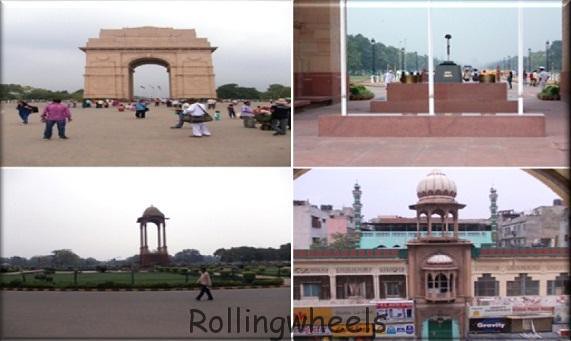
At 10.05 am we were busy packing their luggage at our bikes and started for Chandigarh.
Destination of the Day: Chandigarh
To Be Continued…